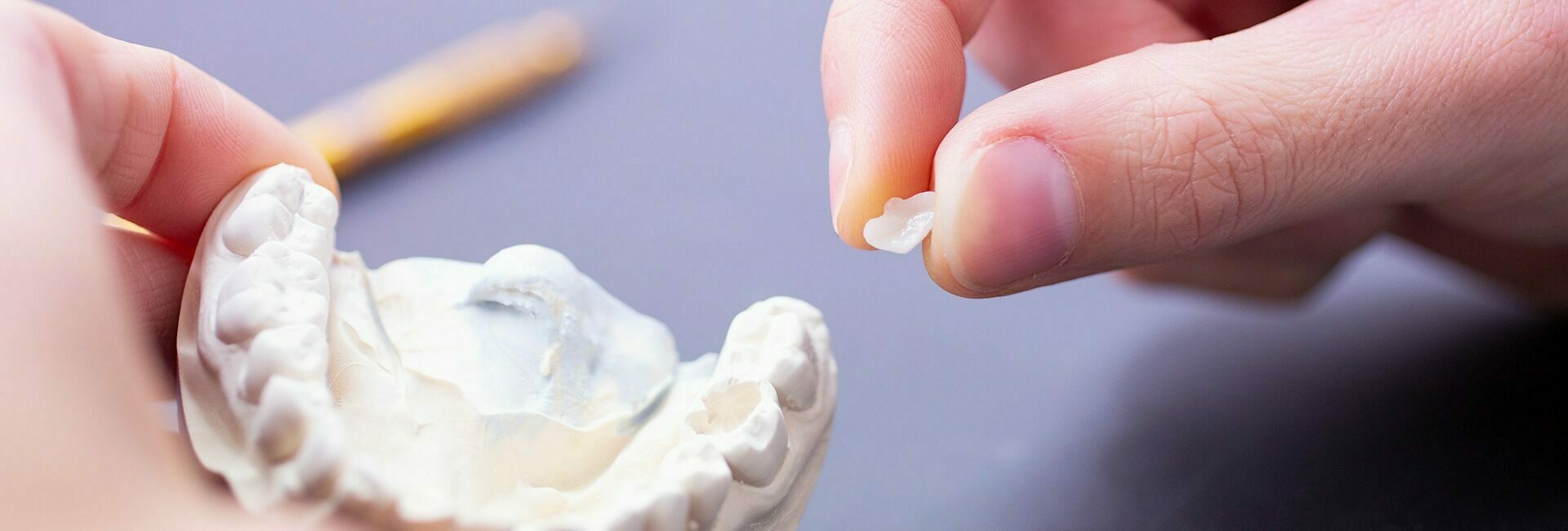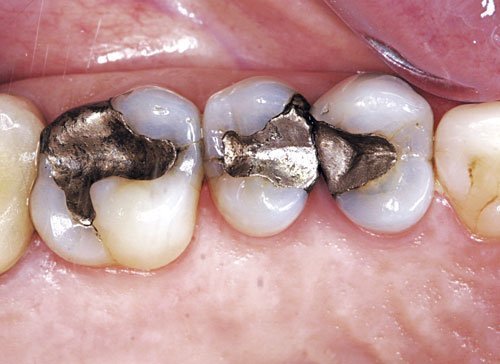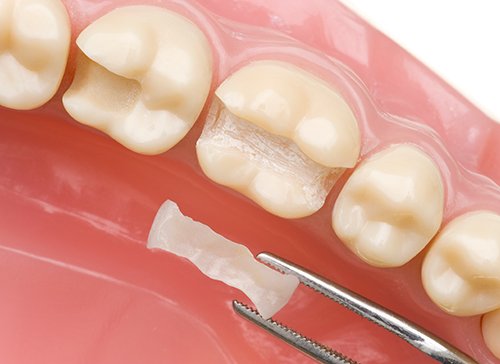
Ceramic fillings (inlays) – “CEREC”
In order to close up a tooth defect due to tooth decay (a hole or cavity), there are varying different levels of treatments available when it comes to quality. On a basic level, the defect must be closed up and sealed against invading bacteria. This is because caries (areas of tooth decay) are themselves the result of destruction caused by bacteria. In order to eliminate these bacteria, the dentist drills away any infected (and therefore weakened) tooth material and fills the cavity that results with a filling material. In order to prevent reinfection by these bacteria at this already weakened point, the seal on the tooth must reliably prevent new bacteria from entering. To achieve this, not only can a range of different materials be used, but completely different techniques can be applied too.
First, we have the most relied upon method of creating bacteria-proof fillings: a mouldable (plastic) material that can be pressed into the cavity and then hardened, the plastic filling. This includes such well-known materials as amalgam, cement and composite materials. It has been shown, however, that all of these substances have serious disadvantages. And thus, a new method was born: hand-crafted manufacture of an exactly-fitting, hard filling in the dental laboratory, which can then be placed into the tooth cavity and a stable bond applied (inlays). This method is much more elaborate, but the tight-fit and durability of these inlays are excellent even over the long term. Inlays are created by dental technicians in a similar process to creating dentures from gold, composite materials, or ceramic. These are then bonded into the tooth using either cement or a synthetic material.


Here we will describe the different techniques available for fillings that are used around the world.
Amalgam fillings: a plastic filling material Patient tend to dislike this material due to its black colour, and a mercury content of 50% raises concerns over its compatibility in the body. Despite extensive scientific research, however, it could not be definitively proven that the substance was harmful. In our opinion, this material cannot be recommended in any case due to its increased risk of causing damage to the surrounding tooth substance because of its property of continuous material expansion over the years. Even so, it must be said that these fillings do create a very tight seal.
Cement fillings: as these fillings are easily worn down, they can only be used for temporary fillings. The clear advantage is due to excellent sealing properties.
Composite fillings: these fillings are popular and widely used as, at a first glance, they are quite simple to apply. In terms of aesthetics, their appearance is also very nice. You may have noticed an “at a first glance” there… This apparent simplicity quickly disappears when the dentist is forced to use different techniques to overcome the biggest shortcoming of this material: it shrinks significantly when it is hardened in the cavity, creating a hair-width gap around the filling. For bacteria, though, this gap is like an open barn door. They can invade into the gap created on hardening of the material and can get very close to the nerve. And then we come to appearance: the border areas with the natural tooth material in particular become darker, meaning that the edge of the filling and the material itself often become darker and more visible. Increased wear and oestrogen content (depending on the exact material type) are almost insignificant disadvantages when compared with the clear shortcomings due to this material’s poor sealing quality.

Now we come to inlays: setting aside the less common composite inlays, gold inlays have represented the highest in quality for many years. Even by modern standards they create a very high-quality filling. One disadvantage is their increased susceptibility to cause damage to unsupported tooth material, and another may be their appearance: in Western cultures, gold no longer gives a desirable look for fillings.
Ceramic inlays: these can be manufactured in different ways, either as pressed ceramic (Empress) or milled ceramic (CEREC). We have been using the CEramic REConstruction (CEREC) manufacturing process in our practices since their introduction in 1987 (Mörmann, Brandestini), i.e. for over 30 years now. It is a manufacturing method that was developed by the University of Zurich. Since then, we have easily applied over 10,000 CEREC inlays. The CAD-CAM milling machines used in our dental laboratories use digital scans of prepared teeth, with technology having improved since their origins, now with levels of precision and material quality that the original inventor could only have dreamt of.
A real community of CEREC dentists emerged, with meetings and international training events, internet media, and very creative user discussions, international industry contacts, and in the early years, very controversial opinions from amongst different universities.
Technology used in the CEREC method: Once the areas of tooth decay (caries) have been removed, the irregular hole (cavity) that is left ensures that as little healthy tooth substance is lost as possible. The surface of the cavity is smoothed off a little. Now a digital scanner takes 3D measurements of the cavity. A special high-quality ceramic from an industrially prefabricated ceramic block is clamped into place in the CAD/CAM milling machine. The 5-axis milling machine carves out the exact shape for the ceramic inlays. The dentist then inserts the ceramic inlay and fixes it into place in a special bonding process.
There are clear advantages to the ceramic inlays when compared with all other dental fillings:
- A highly break-resistant composite even when placed on the thinnest of tooth parts and severely weakened teeth. Tooth and inlay always form a strong bond to each other. The resulting tooth is as stable as a natural, undamaged tooth.
- A hidden shrinking effect of the ceramic inlay is not possible, as it is bonded and set into place as a perfectly fitting part, manufactured in the dental laboratory. –
- As the industrially manufactured ceramic blocks are available in a variety of colours and levels of translucency, inlays can meet all patients’ expectations in terms of aesthetic restorations.
- The compatibility of the bio-ceramic material used is second to none. For our inlays, we use high-quality products exclusively sourced from Germany and Switzerland.
- When compared with treatments using crowns or bridges, treatments with ceramic inlays are more conservative (preserve more tooth material).
As a result of its highly convincing success, the scope of application for inlays became broader and broader, with more complicated solutions becoming available. We, for example, have been using the CEREC process to create an aesthetically-pleasing solution for the front teeth with our ceramic veneers. In this case, the special CEREC ceramic creates a particularly solid solution with a great fit due to their adhesive bonding properties. Here too, the CEREC process can successfully stabilise weakened tooth walls. For larger defects, we can also use the CEREC system with CAD/CAM technology to create onlays, overlays and even implant-supported crowns, and apply these restorations achieving the best-looking results. In the treatment of bruxism, high-quality veneers and onlays that can achieve stunning aesthetic results can be bonded to teeth to build them up.